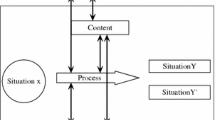Abstract
Organizational fields, in theory, are held to become increasingly isomorphic and standardized over time. At first sight, Sweden's system of higher education is an illustrative case. In its major post-war event, the radical 1977 reform, a variety of means was introduced to pave the way for goal-driven planning and management. The intentions were overall homogeneity and rationality. This is quite in accordance with the theory of organizational fields. Yet, despite intentions, homogeneity remained a rather thin veneer, unable to prevent various forms of disparity from breaking through. Reality, therefore, was more on par with Trow's and others' theses of differentiation in mass higher education; isomorphism taking the place of a formal, inconvenient façade. Effects of four principal reform aspects are discussed in the present article: admission, instruction, institutional classification, and organizational framework. In the analysis of the last-mentioned aspect, a theory of ‘planning cultures’ is introduced. Further changes in the wake of the reform are also touched upon. The results are discussed in a final section, where alternative re-reform measures and outlines for further research are put forth. Intended and unintended consequences, including dysfunctional ones, are subjects of attention throughout the article.
Similar content being viewed by others
References
Ansoff, I. (1979). Strategic Management. London: MacMillan.
Bauer, M. (1986). Vad är det för fel med högskolans utbildningslinjer? Arbetsrapport UHÄ.
Bladh, A. (1983). De studerande och studieorganisationen. Uppföljningsundersökningar 1977–1982. Stockholm: UHÄ-rapport.
Burns, T. and Stalker, G.M. (1961). The Management of Innovation. London: Tavistock.
Cameron, K.S. and Whetten, D. A. (1981). ‘Perceptions of organizational effectiveness over organizational life cycles’, Administrative Science Quarterly 26, 525–544.
Child, J. (1972). ‘Organizational structure, environment, and performance: the role of strategic choice’, Sociology 6, 1–22.
Clark, B.R. (1983). The Higher Education System: Academic Organization in Cross-National Perspective. Berkeley, CA: University of California Press.
Cyert, R.M. and March J.M. (1963). A Behavioral Theory of the Firm. Englewood Cliffs, NJ: Prentice-Hall.
DiMaggio, Paul J. and Powell, Walter W. (1983). ‘The iron cage revisited: institutional isomorphism and collective rationality in organizational fields’, American Sociological Review 148, 147–160.
Donaldson, L. (1987). ‘Strategy and structural adjustment to regain fit and performance: in defense of contingency theory’, Journal of Management Studies 24, 1–24.
Durkheim, E. (1966). Suicide. New York: Free Press.
Enderud, H.G. (1977). Four Faces of Leadership in an Academic Organization. København: Universitetsførlaget.
Faludi, A. (1973). Planning Theory. Oxford: Oxford University Press.
Feyerabend, P. (1988). Farewell to Reason. London: Verso.
Geertz, C. (1973). The Interpretation of Cultures. New York: Basic Books.
Greiner, L.E. (1972). ‘Evolution and revolution as organizations grow’, Harvard Business Review 50, 37–46.
Jansson, L. (1983). Högskoleindelningen-arbetsdelning och samverkan inom högskolan. UHÄ-rapport.
Jönsson, S.A. and Lundin, R.A. (1977). ‘Myths and wishful thinking as management tools’, in Nystrom, P.C. and Starbuck, W.H. (eds.), Prescriptive Models of Organizations. New York: North-Holland, pp. 157–170.
Katz, D. and Kahn, R.L. (1978). The Social Psychology of Organizations. New York: Wiley.
Kets de Vries, M.F.R. (1980). Organizational Paradoxes. Clinical Approaches to Management. London: Tavistock.
Kim, L. (1979). Två års erfarenheter av de nya tillträdesreglerna till högskoleutbildningen. Stockholm: UHÄ-rapport.
Lane, J.-E. and Fredriksson, B. (1983). Higher Education and Public Administration. Stockholm: Almqvist and Wiksell International.
Lawrence, P.R. and Lorsch, J.W. (1967). Organization and Environment. Boston: Harvard University Press.
Lindensjö, B. (1981). Högskolereformen. En studie i offentlig reformstrategi. Stockholm Studies in Politics, 20.
March, J.G. and Olsen, J.P. (eds.) (1976). Ambiguity and Choice in Organizations. Bergen - Oslo - Tromsø: Universitetsforlaget.
March, J.G. and Simon, H.A. (1958). Organizations. New York: Wiley.
Melin, L. (1983). ‘Studieorganisationen ur ett institutionsperspektiv’, in M. Bauer (red.), På rätt kurs i högskolan. Erfarenheter av högskolans studieorganisation. UHÄ-rapport. Stockholm: LiberTryck.
Meyer, J.W. and Rowan, B. (1977). ‘Institutionalized organizations: formal structure as myth and ceremony’, American Journal of Sociology 83, 340–363.
Miller, D. and Friesen, P.H. (in collaboration with H. Mintzberg) (1984). Organizations: A Quantum View. Englewood Cliffs: Prentice-Hall.
Mintzberg, H. (1983). Power in and around Organizations. Englewood Cliffs, NJ: Prentice-Hall.
Månsson, P. and Sköldberg, K. (1979a). Vision och verklighet. Regionnivån i den nya högskolan. UHÄ-rapport.
Månsson, P. and Sköldberg, K. (1979b). Vision och verklighet. Linjenämnderna i den nya högskolan. UHÄ-rapport.
Månsson, P. and Sköldberg, K. (1980a). Vision och verklighet. Enhetsstyrelserna i den nya högskolan. UHÄ-rapport.
Månsson, P. and Sköldberg, K. (1980b). Vision och verklighet. Bilder från institutionsnivån i den nya högskolan. UHÄ-rapport.
Månsson, P. and Sköldberg, K. (1983). Symboliska organisationsmönster. Sju typer av planeringskultur under osäkerhet och stress i ett metamorfosperspektiv. (Symbolic Organizational Patterns. Seven Types of Planning Culture under Uncertainty and Stress in a Metamorphosis Perspective.) Studier i företagsekonomi, serie B, Företagsekonomiska institutionen, Umeå universitet.
Pfeffer, J. (1981). Power in Organizations. London: Pitman.
Pfeffer, J. (1982). Organizations and Organization Theory. Boston: Pitman.
Premfors, R. (1980). The Politics of Higher Education in a Comparative Perspective. France, Sweden, United Kingdom. Stockholm: Stockholm Studies in Politics, 15.
Premfors, R. and Östergren, B. (1978). Systems of Higher Education: Sweden. New York: International Council for Educational Development.
Pugh, D.S. and Hickson, D.J. (1976). Organizational Structure in Context. Westmead, Farnborough, Hants.: Saxon House.
Schumpeter, J.A. (1961). The Theory of Economic Development. London: Oxford University Press.
Selye, H. (1974). Stress without Distress. New York: Signet.
Shani, M. (1974). ‘Future studies versus planning’, Omega 2, 635–649.
Sköldberg, Kaj (1991). Reformer på vridscen. Organisationsförändringar i kommun och landsting. Lund: Studentlitteratur.
Steiner, G.A. (1969). Top Management Planning. London: MacMillan.
Teichler, U. (1988). Changing Patterns of the Higher Education System. The Experience of Three Decades. London: Jessica Kingsley Publishers.
Trow, M. (1974). ‘Problems in the transition from elite to mass higher education’, in Policies for Higher Education. Paris, OECD, pp. 51–104.
Tsoukas, H. (1989). ‘The validity of ideographic research explanations’, The Academy of Management Review 14, 551–561.
Weber, M. (1969). The Theory of Social and Economic Organization. New York: Free Press.
Woodward, J. (1965). Industrial Organization: Theory and Practice. New York: Oxford University Press.
Author information
Authors and Affiliations
Rights and permissions
About this article
Cite this article
Sköldberg, K. Strategic change in Swedish higher education. High Educ 21, 551–572 (1991). https://doi.org/10.1007/BF00134988
Issue Date:
DOI: https://doi.org/10.1007/BF00134988




